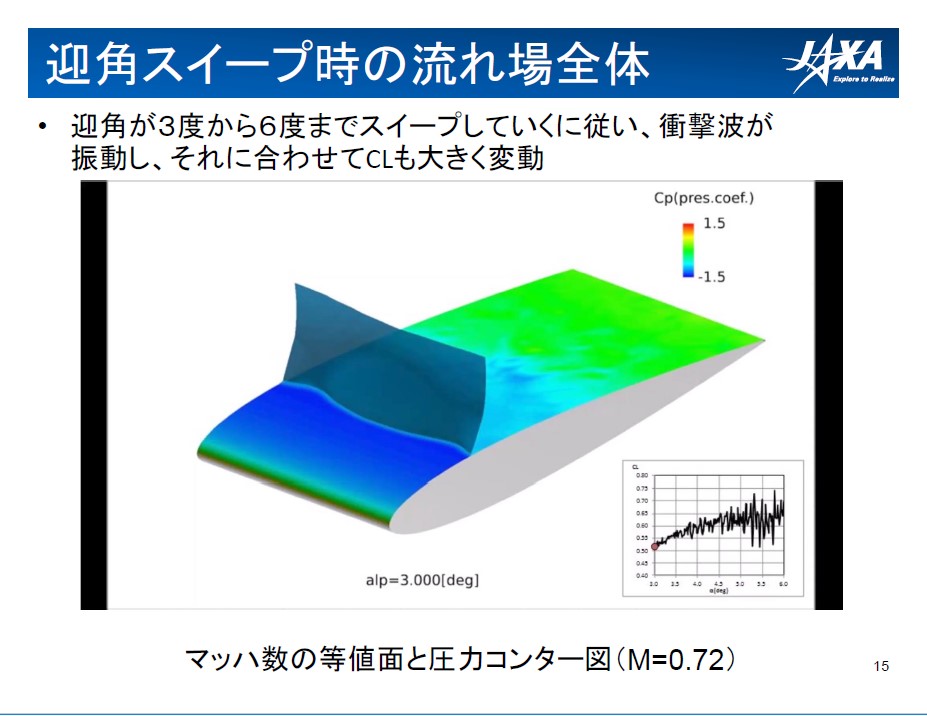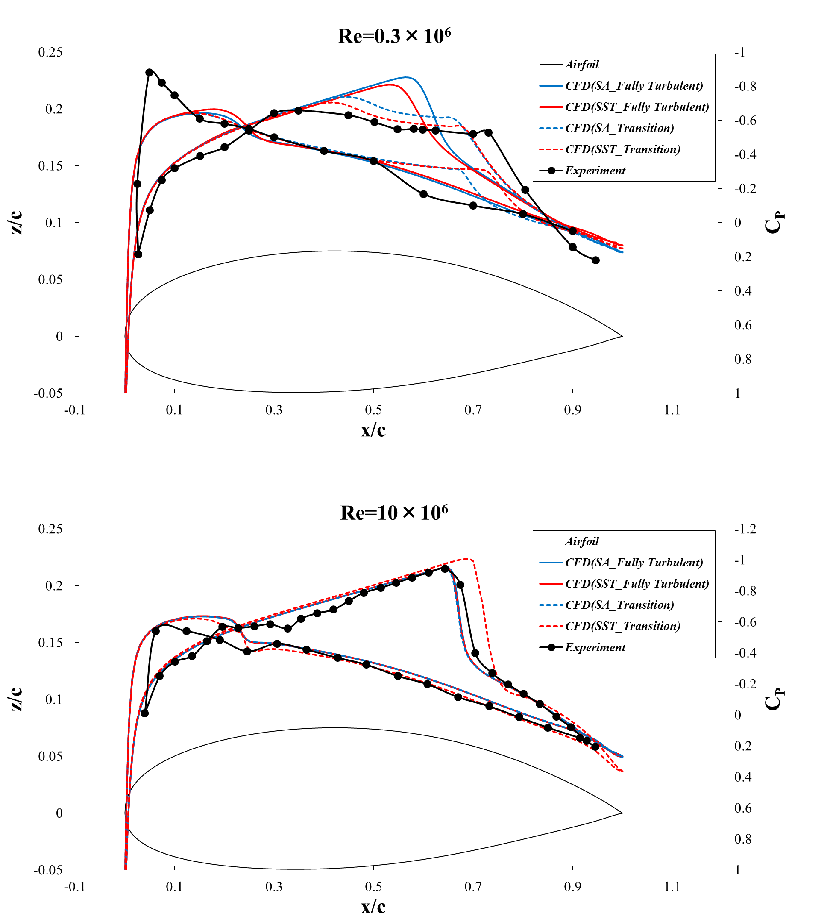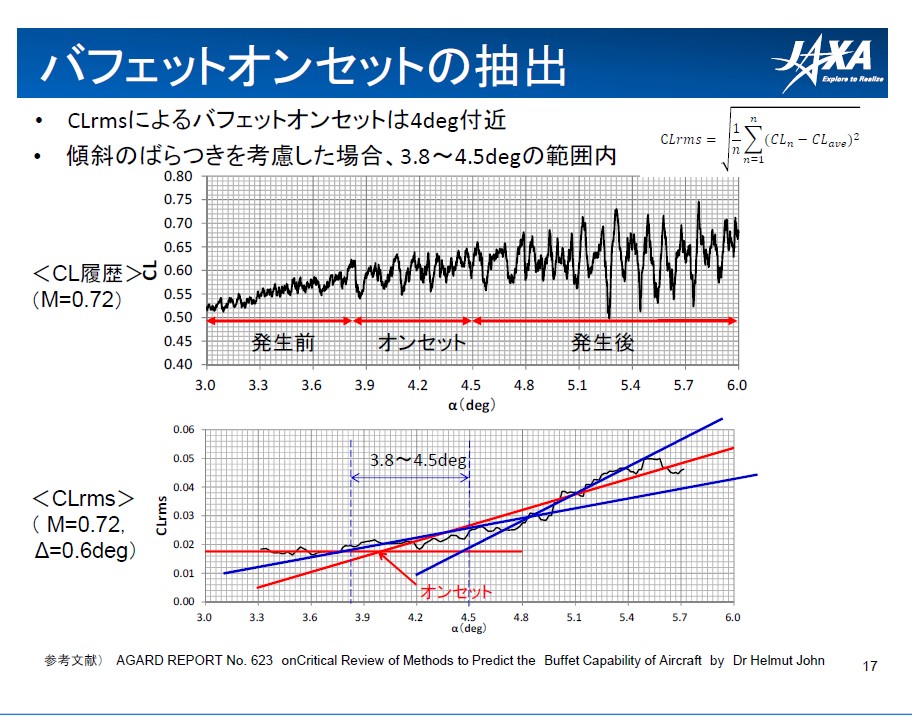Studies on real flight aerodynamic prediction
JAXA Supercomputer System Annual Report April 2017-March 2018
Report Number: R17EA3602
Subject Category: Aeronautical Technology
- Responsible Representative: Takeshi Ito, Aeronautical Technology Directorate, Next Generation Aeronautical Innovation Hub Center
- Contact Information: Kazuyuki Nakakita nakakita@chofu.jaxa.jp
- Members: Keiko Kawaguchi, Kazuyuki Nakakita, Kanako Yasue, Rie Tagai, Makoto Ueno, Mitsuhiro Murayama, Kentaro Tanaka, Tohru Hirai, Yasushi Ito, Keita Hatanaka, Suzuki Kohji, Takahiro Uchiyama, Hiroya Toriida, Shu Yamagishi
Abstract
Through a series of aerodynamic design sequence in the aircraft development, we aim to speed up that sequence by cutting-edge technologies which enable us to avoid from the delay of the development and speed-up the aerodynamic sequence.
By applying the sophisticated data analysis techniques to high-speed buffet data produced by unsteady CFD, a technology to detecting the sign and location of buffet phenomena is developped. An analysis to replicate Reyunolds number effect appeared on aerodynamic characteristics is also conducted to develop the future real flight aerodynamic prediction .
Reference URL
N/A
Reasons for using JSS2
A huge parallel computar like JSS2 is required to carry out large-scale analysis for unsteady buffet phenomena and high precision computations for evaluating the Reynolds number effect.
Achievements of the Year
For the research of beffet onset detection, unsteady CFD calculation introducing DES was applied to 2-dimensinal NACA0012 airfoil at M=0.72 and AOA=3 to 6 degree. (Fig. 1) The buffet onset was detected from the unsteady CFD results by the conventional method using CLrms. (Fig. 2) The unsteady CFD results was also used for the develpment of new buffet onset detection techniques using data-mining methods.
The Reynolds number research was conducted using the airfoil of the C-141 aircraft, which was occurred a problem due to Reynolds number effect. The Reynolds number effect of C-141 airfoil was evaluated in wide range of Reynolds number variations. (Fig.3)

Fig.1: Pressure distribution including shock-wave location on a NACA0012 airfoil at M=0.72 and AoA=3deg.

Fig.3: Pressure distribution around a quasi 2-dimensional C-141 airfoil employing transition model for turbulence modeling.
Publications
■ Peer-reviewed papers
1) Yamazaki, W., Yamagishi, S., and Ueno, M,. “Investigation of Indirect Reynolds Number Effect via Computational Fluid Dynamics Simulations”, Journal of Aircraft, Posted online on 30 Jan 2018.
■ Non peer-reviewed papers
1) Kazuhisa Chiba, Yuhei Umeda, Naoki Hamada, Shinya Watanabe, Masaya Nakata, Kanako Yasue, Koji Suzuki, Takashi Atobe, Shigeru Kuchi-Ishi, Kazuyuki Nakakita, Takeshi Ito, Determination of Temporal and Spatial Origination of Transonic Buffet via Unsteady Data Mining, AIAA 2018-0036, 2018 AIAA Aerospace Sciences Meeting, 2018.
2) Yamazaki, W, Yamagishi, W and Ueno, M., “Investigation of Indirect Reynolds Number Effect via Computational Fluid Dynamics Simulations,” 35th AIAA Applied Aerodynamics Conference, AIAA 2017-3404, 2017.
3) Yamazaki, W, Yamagishi, W and Ueno, M., “Investigation of Indirect Reynolds Number Effect of C-141 Aircraft Model,” Proceedings of the Fourteenth International Conference on Fluid Dynamics, 2017.
Usage of JSS2
Computational Information
- Process Parallelization Methods: MPI
- Thread Parallelization Methods: N/A
- Number of Processes: 128 – 512
- Elapsed Time per Case: 720.00 hours
Resources Used
Fraction of Usage in Total Resources*1(%): 1.92
Details
Please refer to System Configuration of JSS2 for the system configuration and major specifications of JSS2.
| System Name | Amount of Core Time(core x hours) | Fraction of Usage*2(%) |
|---|---|---|
| SORA-MA | 15,973,279.51 | 2.13 |
| SORA-PP | 12,985.28 | 0.16 |
| SORA-LM | 313.00 | 0.16 |
| SORA-TPP | 0.00 | 0.00 |
| File System Name | Storage Assigned(GiB) | Fraction of Usage*2(%) |
|---|---|---|
| /home | 130.33 | 0.09 |
| /data | 25,241.03 | 0.47 |
| /ltmp | 8,191.38 | 0.62 |
| Archiver Name | Storage Used(TiB) | Fraction of Usage*2(%) |
|---|---|---|
| J-SPACE | 5.27 | 0.23 |
*1: Fraction of Usage in Total Resources: Weighted average of three resource types (Computing, File System, and Archiver).
*2: Fraction of Usage:Percentage of usage relative to each resource used in one year.
JAXA Supercomputer System Annual Report April 2017-March 2018



